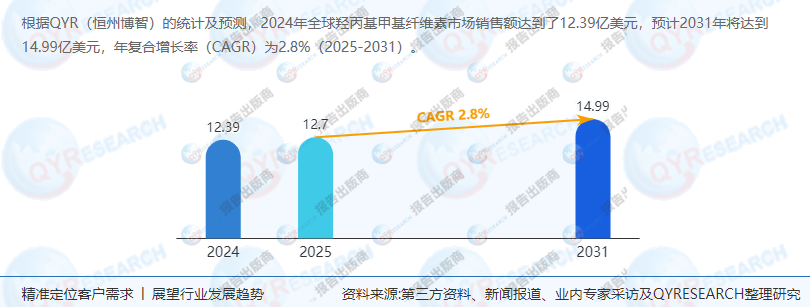This report aims to comprehensively analyze the current status, development trends and industry prospects of the global and Chinese hydroxypropyl methylcellulose (HPMC) market. Through detailed data statistics and in-depth analysis, it provides decision-making references for professional investors, helps them seize market opportunities and maximize investment returns.

2. Definition and Use of Hydroxypropyl Methylcellulose (HPMC)
Hydroxypropyl Methylcellulose (HPMC) is an important non-ionic cellulose ether, widely used in many industries such as construction, coatings, personal care, and pharmaceuticals. In the construction industry, HPMC, as an important additive, can improve the adhesion, water retention and construction properties of mortar and putty; in the coating industry, it acts as a thickener and stabilizer to improve the stability and leveling of coatings; in personal care products, HPMC acts as a film former and thickener to enhance the stability and use experience of the product; in the pharmaceutical field, HPMC acts as an adhesive and coating material for tablets and capsules, and has a wide range of application value.
3. Supply Chain Structure and Upstream and Downstream Analysis
The supply chain structure of hydroxypropyl methylcellulose (HPMC) includes raw material suppliers, manufacturers, distributors and end users. Upstream raw materials mainly include cellulose, propylene oxide, methanol, etc. The price fluctuations of these raw materials directly affect the production cost of HPMC. Midstream manufacturers convert raw materials into HPMC products through chemical synthesis or modification processes, and produce different specifications and grades according to market demand. Downstream distributors sell HPMC products to end users in the construction, coatings, personal care, pharmaceutical and other industries.
IV. Introduction to major manufacturers
The major manufacturers in the global hydroxypropyl methylcellulose (HPMC) market include multinational companies such as Ashland, DuPont, Shin-Etsu, and local companies such as LOTTE Fine Chemical, Hercules-Tianpu, and Shandong Everbright Technology Development. These companies have their own advantages in technical strength, market share, brand influence, etc., and jointly promote the development of the global HPMC market. Among them, Ashland, DuPont and Shin-Etsu account for about 52% of the global market share and are the market leaders.
V. Policies and market dynamics
The regulatory policies of various governments on environmental protection, production safety and other aspects have an important impact on the development of the hydroxypropyl methylcellulose (HPMC) industry. At the same time, with the recovery of the global economy and the continued development of industries such as construction, coatings, personal care, and pharmaceuticals, the demand for HPMC will continue to grow. In addition, technological innovation and industrial upgrading are also important factors driving the development of the HPMC industry.
VI. Market Status and Trend Analysis
Market size: According to the latest research report of QYResearch, the global hydroxypropyl methylcellulose (HPMC) market sales reached US$1.239 billion in 2024, and is expected to reach US$1.499 billion in 2031, with a compound annual growth rate (CAGR) of 2.8%.
Regional distribution: The Chinese market has changed rapidly in the past few years. Although specific data is not given, it is expected that the share of the Chinese market in the global market will increase year by year. North America, Europe, Japan, South Korea and other regions are also important participants in the HPMC market.
Product type and application: HPMC products are mainly divided into three types: industrial grade, food grade and pharmaceutical grade. Among them, industrial grade HPMC is mainly used in industries such as construction and coatings; food grade HPMC is used in personal care and other fields; pharmaceutical grade HPMC is used in the pharmaceutical field. From the application perspective, the construction industry is the largest application field of HPMC, accounting for about 60% of the market share.
VII. Future market forecast
In the next few years, the global hydroxypropyl methylcellulose (HPMC) market will continue to maintain steady growth. With the continuous development of industries such as construction, coatings, personal care, and pharmaceuticals, as well as the promotion of technological innovation and industrial upgrading, the market demand for HPMC will continue to grow. At the same time, the Chinese government's regulatory policies on environmental protection and production safety will prompt the HPMC industry to develop in a more green, safe, and efficient direction. Therefore, investors should pay close attention to market dynamics and technological development trends and seize market opportunities.
VIII. Analysis of upstream and downstream of the industrial chain
In the upstream of the industrial chain, price fluctuations of raw materials such as cellulose, propylene oxide, and methanol will directly affect the production cost and market competitiveness of HPMC. Therefore, manufacturers need to pay close attention to changes in raw material prices and take measures to reduce production costs. In the downstream of the industrial chain, market demand in industries such as construction, coatings, personal care, and pharmaceuticals will directly affect the sales volume and market share of HPMC. Manufacturers need to strengthen cooperation and communication with downstream customers, understand changes in market demand, and adjust production strategies in a timely manner.
IX. Industry Insights and Opportunities
With the recovery of the global economy and the continued development of industries such as construction, coatings, personal care, and pharmaceuticals, the hydroxypropyl methylcellulose (HPMC) industry will usher in more development opportunities. At the same time, technological innovation and industrial upgrading will also bring new growth points to the HPMC industry. For example, the development of environmentally friendly, high-performance HPMC products will meet the market demand for high-quality, green products; the construction of intelligent and automated production lines will improve production efficiency and quality stability; strengthening cooperation and exchanges with the international market will expand the international market share of HPMC products.